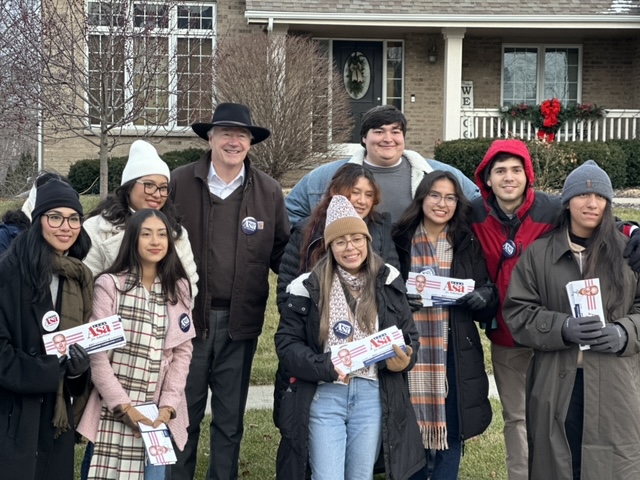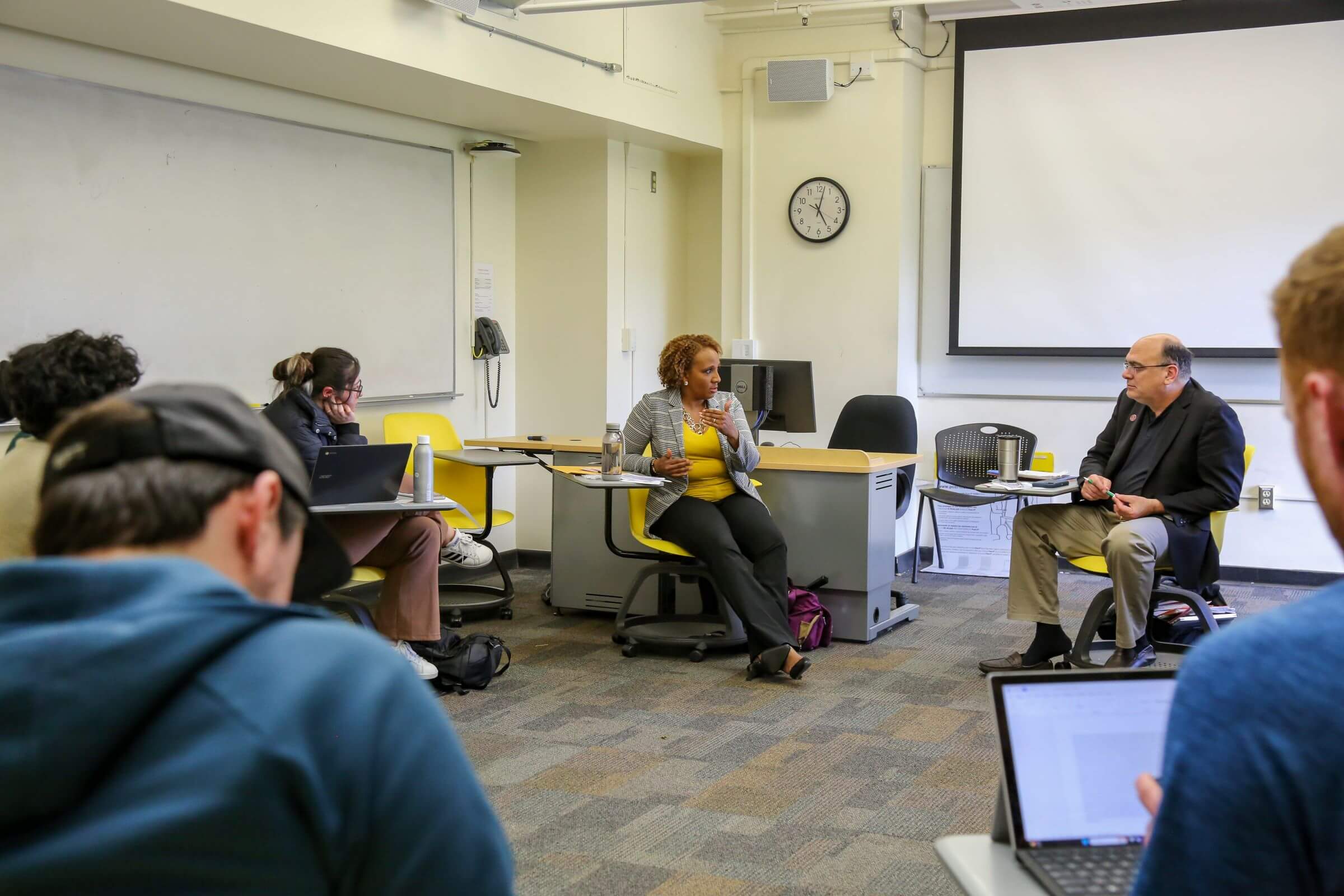With elections in the United States only taking place every two or four years, the California State University embraces the opportunity during election season to provide students interested in politics or public service with unique hands-on learning experiences. This presidential election year, students across the CSU are getting real-life exposure to political processes, election administration and campaign finance.
CPP Goes to Iowa
In a unique opportunity only available during presidential election years, a group of 13 political science students and two professors from Cal Poly Pomona visited Des Moines, Iowa, to engage in campaign activities ahead of the
2024 Iowa Caucus.
“What I think is important for students to understand is that there are a number of electoral processes here in the United States,” says Jarred Cuellar, CPP assistant professor of political science. “We saw the difference between a general presidential election and the various ways the 50 states conduct their nominating process, which include caucuses like in Iowa. Also, the students got to see how political behavior is linked to campaigns and elections along with the role of federalism in presidential elections. Furthermore, they saw firsthand the significant influence that comes with being the first state in the nominating process. They got to see all forms of American politics come to life.”
The Iowa Caucus differs from primary elections in that it brings voters from either the Republican or Democrat party together for open discussion and a secret ballot vote to choose the party’s candidate. It has historically been a key indicator for presidential primary elections. In 2024, the caucus focused on the Republication presidential nominee, and former President Donald Trump won with 51% of the votes.
The CPP group visited January 2 through 9 to coincide with campaign events preceding the caucus. While students did not attend the caucus itself, they were able to engage with presidential candidates, including door-to-door canvassing with former Arkansas Governor Asa Hutchinson, participating in a Q&A and personal conversations with Florida Governor Ron DeSantis and attending a Trump rally.

CPP students canvas with former Arkansas Governor Asa Hutchinson, center.

The group gathers before a Trump rally.
“It’s strange, coming from a California perspective, being able to not only see the candidates in person, but to actually speak with them,” says Zé Manuel Ferreyra, ‘24 political science graduate. “You probably would never have the chance to do that in California given that it’s such a big state with so many people.”
The field trip also allowed the students to see topics they had learned about in the classroom play out in real-world environments. “A lot of these students took the ‘Voting in Elections’ course with me the semester prior … and it was a lot of what we learned in that class come to life,” Cuellar says. The students realized “this behavior is not confined to a class or textbook, this actually happens.”
The field trip kicked off Cuellar’s semester-long special topics course, “Iowa: 2024 Nominations.” Through discussion and academic papers, the students were tasked with considering the impacts of the Iowa Caucus and other early primary elections like those in New Hampshire and Michigan, as well as the benefits and challenges with upcoming changes to the order of the state primaries.
“The experience I got from Iowa was that a lot of people need help; a lot of the Iowa people share a lot of the struggles that California people feel,” Ferreyra says. “No matter where you are, there are always going to be unhoused people, people who are trying to make ends meet, people who struggle with food insecurity. I want to dedicate my life, my work going forward to trying to do whatever we can to address those issues.”
The Campaign Trail
However, other CSUs also offer special election-year courses to prepare political science students for their future careers.
At CSU Channel Islands, Adjunct Professor Tim Allison teaches a
Campaigns and Elections course during both presidential and midterm election years. Throughout the semester, students write recap papers on elections, develop a campaign plan and track competitive U.S. Senate and Congressional races. During presidential election years, like 2024, Allison incorporates activities related to the electoral college, helping students understand how presidential candidates can garner the needed 270 votes. He also brings in local candidates running for public office to speak with the students.

The Ventura County Registrar of Voters Michelle Ascencion, center, visits with CSUCI Professor Tim Allison, right, and his class.
“Some of the candidates won, some of the candidates lost, but all of them had an interesting perspective on what it was like to run for office and what students should know about the campaign process,” Allison says.
In addition, students gain hands-on experiential learning through a mandated 15 hours of volunteer work, like phone banking or precinct walking, with a campaign of their choice. In spring 2024, students volunteered for campaigns in four different California counties with candidates running for county board of supervisors, judge and city council, among others.
“That practical learning experience was a fascinating one for the students,” Allison says. “Over the course of the semester, they got to see campaigns from a textbook perspective, from a candidate’s viewpoint and from the inside of a campaign.”
During the spring 2024 semester, Allison ran for and won a delegate position for the Democratic National Convention in Chicago, which allowed students to track his own campaign journey.
“I think students were able to have a class that wasn’t just reading about a subject; it was living it, learning it while they’re working on it,” he says.
Insider Look
At Fresno State, Associate Professor of Political Science Lisa Bryant also teaches a Campaigns and Elections course, offered only during presidential election years, but with a unique focus: election administration. This focus includes the logistics of conducting an election and election law.
“It’s important for people to understand how elections work, and the best way for people to have trust in the system is seeing how the system works,” Bryant says.
To augment classroom learning, Bryant brings in election officials and candidates to discuss the backend of elections, as well as has students perform a post-election analysis of the presidential race, including how and why the official vote tally may not be complete until a month after the election.
Her students also engage in experiential learning by volunteering for the election—whether as poll workers, voting rights advocates with observations groups or attorneys, operators on the voter helpline for the League of Women Voters, election runners for the County Clerk’s office or workers at the elections warehouse.
“One of the missions of the university is to try and build informed citizens and the next generation of leaders,” Bryant says. “Understanding how our democratic process works—not just the three branches of government but the nuts and bolts of how people get elected—is really important for community leaders to know.”
Bryant does still incorporate campaign topics into the course though, such as party organizations’ operations, campaign advertising, voting districts and the electoral college. One major assignment requires students to track a competitive congressional district race throughout the semester, including analyzing campaign advertising, district boundaries and voting tallies on election night.
Additionally, in fall 2024, Bryant will be adding a section on misinformation and disinformation as deep fakes and artificial intelligence become more widespread and produce false information that can influence elections.
Follow the Money
But elected positions are not the only items on the docket. Voters also see any number of federal, state or local ballot measures. In fall 2024, California will likely vote on between 15 and 24 ballot measures with associated campaign spending that could exceed $1 billion.
Sonoma State Political Science Professor David McCuan ensures the students in his Elections and Voter Behavior course—which takes place in the fall semester during presidential and midterm election years—understand the history, context and implications of these measures.
“I teach the students how to track money in politics, which is a big deal,” he says. “It’s a real skill, and I join that with how the money is being spent—so not just who’s giving money, but what are the spending strategies.”
Working with the League of Women Voters in Marin and Sonoma counties, the students help analyze the pros, cons and background information, specifically campaign finances, of upcoming ballot measures. They present the information during
events and workshops to help voters understand the measures—as well as provide the data to journalists, helping them accurately report on the measures.
“The students learn skill sets like where to get the data, how to understand that data and how the data has lagged,” McCuan says. “Then, that lends itself to understanding the media strategy. The great thing is the consultants, or the political professionals, know I’m training students to do this work, so they hire them. In that sense, it provides a pipeline.”
In addition, students monitor the election results, reflect on their experience and participate in gamified activities to predict and track election outcomes—including a look at the path to 270 electoral college votes during presidential election years.